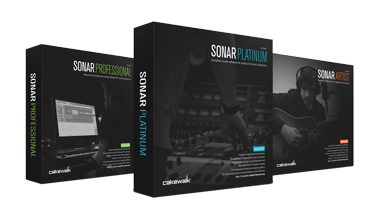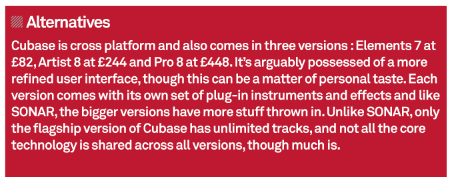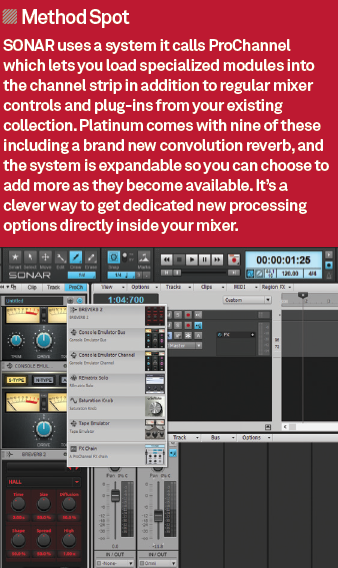Cakewalk Sonar Platinum Review
SONAR has always been a mainstay of the Windows music production world, but what does the latest version bring? Hollin Jones fires up his radar… Details Price SONAR Platinum £399 SONAR Professional £159 SONAR Artist £79 Distributor Cakewalk Contact Via website Web www.cakewalk.com System requirements OS: Windows 7 or 8 (32 or 64 bit) Processor: 2GHz Intel […]

SONAR has always been a mainstay of the Windows music production world, but what does the latest version bring? Hollin Jones fires up his radar…

Details
Price SONAR
Platinum £399 SONAR Professional £159 SONAR Artist £79
Distributor Cakewalk
Contact Via website
Web www.cakewalk.com
System requirements OS: Windows 7 or 8 (32 or 64 bit) Processor: 2GHz Intel or AMD multi-core processor Memory: 4GB, Hard Drive: 5GB for minimal install, 20GB recommended
SONAR is one of the longest-established DAWs on the Windows platform and can trace its roots back to the app then named Cakewalk in the 1990s. It was one of the first DAWs to really get behind digital audio recording and has consistently been at the forefront of technological development on the PC, even if it has sometimes not received as much attention as some of its competitors.

For a long time this could be at least partly attributed to its interface, which had started to lag behind the others in terms of usability and looks. That all changed with the new Skylight interface in Sonar X1 which brought a sleek new design and dockable sections to make it feel much more up to date

There are relatively few DAWs that are single-platform, but SONAR is one. Cakewalk actually does develop some of its instruments as dual platform for Mac and PC and also codes for the iPad, but it seems likely that SONAR’s long history of being Windows-only means there’s too much legacy code to facilitate easy porting to the Mac. Stranger things have happened though, like Wavelab getting Mac support or Digital
 Performer becoming available for PC, so never say never. For now you’ll need Windows 7 or 8, 32 or 64-bit, though overall the system requirements are fairly modest by today’s standards. Cakewalk does a lot of work under the hood and SONAR was one of the first truly 64-bit DAWs, so performance has always been more than respectable.
Performer becoming available for PC, so never say never. For now you’ll need Windows 7 or 8, 32 or 64-bit, though overall the system requirements are fairly modest by today’s standards. Cakewalk does a lot of work under the hood and SONAR was one of the first truly 64-bit DAWs, so performance has always been more than respectable.
Command and Control
The first big new feature is Command Centre, an application that acts as a hub for your authorisations and downloads. As a concept this is becoming increasingly popular, and NI, Steinberg and others use systems with similar (though not identical) elements. Tied to your Cakewalk user account, it provides access to download all your purchased products and also handles installation too, so there’s less fiddling about generally.
You can download different sets of content separately, which is handy when you have the Platinum version with all its goodies, and also manage updates and reinstalls from inside the app. Cakewalk also reckons you will be able to roll back to previous versions of SONAR without affecting the rest of your system, which could be handy for troubleshooting.
Another interesting development is that you now get 12 months of SONAR membership with any version of the software. This entitles you to new feature updates, custom content, videos, new presets and free tech support every month.
Even if you don’t renew your membership, you keep everything you’ve already received. If you don’t renew, you still get the same support you always would have, but your software version is ‘frozen’ at the version it’s currently on, and you won’t get updates without re-subscribing. Cakewalk says that under this new system it will be issuing more frequent updates to members.
SONAR is a fully featured audio and MIDI recording and production environment and all three versions – Artist, Professional and Platinum, share the same core features. Unlike some DAWs, even the entry level version allows unlimited audio, MIDI, FX and send tracks and it also has a decent selection of effects and instruments.
The Professional version adds a more advanced selection of plug-ins, and the Platinum version yet more plugs as well as tape and console emulation and the new VocalSync technology.
Perhaps more than any other tiered DAW range, Cakewalk is really generous with its lower-priced versions and you get the same core technology so you can still do a lot even if your budget is modest.
Interface Tweaks
The Skylight interface introduced in X1 really revolutionized the way SONAR works, sweeping away the old look which had got rather stale. It’s still really flexible, with almost all sections of the interface available to be docked, floated, rearranged and resized freely.
There have been tweaks and improvements in X4 (the unofficial name of this new version) including enhancements to the Control Bar.
Icons are more legible and contrast is better, and it can be extensively customized via right click and by rearranging individual sections. It’s scrollable too, so you can navigate to extra sets of controls. The Console view now also allows stacking of as many effects and sends as you like which makes it easier to see all the elements of a mix.
The workflow is reassuringly straightforward in that you get multiple track types and a linear project area in which to record and edit audio and MIDI. There are track templates that can load up entire setups to save time, and of course FX chains which do the same for audio processing.
All versions of SONAR come with a core set of instruments and effects including all the kinds of mix effects you need in day to day situations, plus instruments like Session Drummer 3, Roland GrooveSynth, TTS-1, DropZone and the Studio Instruments : drums, bass, strings and electric piano. The bigger versions of SONAR add Dimension and Rapture LE, Cyclone, Pentagon and Z3TA+, and Platinum gives you Lounge Lizard and Strum Acoustic special editions plus TruePianos Amber.

Plug-ins Galore
Platinum also gives you 16 virtual custom amps and Addictive Drums 2 Producer Bundle as well as the Overloud TH2 Producer amp sim and Melodyne Essential which is great for editing your vocal performances. SONAR has the ProChannel system for creating channel strips and to the existing mix tools, the flagship bundle adds Console and Tape emulator modules for an authentic vintage analogue sound.
In fact you get nine ProChannel modules with Platinum and the option to add more, as well as 19 Nomad Factory Blue Tubes FX and QuadCurve EQ Zoom with Analyzer for a grand total of 21 instruments and 57 audio effects.
Of particular note is the new ReMatrix Solo, a zero-latency convolution reverb from Overloud that you will probably end up using as your go-to reverb when mixing. The existing stuff is still here too, including the advanced Linear Phase mix and mastering plug-ins.
SONAR has always given you a lot of content and this is still the case. If you do opt for the full Platinum version you get everything you need to compose and produce, plus of course in all versions there’s full VST3 support with multi-out functionality.

Mix Options
Another useful new feature is Mix Recall. Accessible from the Control Bar, this lets you save and switch between multiple mixer setups and is configurable to include some or all mix parameters, meaning you can leave some routing intact while changing other settings if you like.
Swap out effects, fader positions, automation and so on to compare different treatments without having to duplicate a project first. You can use this system to set up multiple mixes, say for radio, MP3, vinyl and so on, and then export all versions at the same time.
Mix Recall is genuinely useful and will help you make better mix decisions. Sticking with the I/O theme, DSD import and export is now supported, meaning you can work with Super Audio CD-resolution audio if you choose. SONAR supports sample rates up to 384kHz.
New in Platinum is VocalSync, a technology that tightens vocals up by aligning one part to another which is invaluable when working with doubled vocals or syncing up dialogue to picture.
It works without splitting or moving clips : you just select a guide track, make some settings and then click to render.
You can sync multiple tracks at once and though probably of particular use to those working with movie sound, it’s still a powerful feature.
Not entirely unrelated is AudioSnap, with new detection algorithms that let you stretch entire songs, sync recordings to audio loops, tighten up drum recordings or convert audio notes to MIDI data. Audio can be made as elastic as MIDI in many DAWs, but SONAR’s implementation is clean and efficient, with a new look to boot.
MIDI Tools
Cakewalk is adept with MIDI too of course, and in addition to the existing programming and editing tools there’s now a Pattern Tool. This selects any MIDI data you click on and makes it available for ‘painting’ into other locations, without the need to drag and drop or use key commands.
As well as working in the piano roll editor, you can highlight a clip in the browser and paint it across a track without needing to import it first. It joins the other tools that make workflow pretty snappy in SONAR, such as the Smart Tool which is able to adapt its function based on the kind of controls or content that you hover it over.
There’s a lot of stuff that’s carried over from the last version of SONAR of course, and this continues to make it a great performance as well as production tool. The Matrix View in particular lets you import content to a grid and then play it live, either by clicking with the mouse or by linking a MIDI controller. SONAR supports Active Controller Technology (ACT) for setting up MIDI devices to control the software.
There’s also a step sequencer built-in for an alternative way to program beats and melodies, and support for scoring, lyrics and video playback as well as surround sound.
The Preferences section, which received a major overhaul to simplify and streamline it a couple of versions back, remains an efficient way to manage your I/O as well as the general behaviour of the application. As you’d hope, exporting is powerful with lots of options for creating stems, multiple output formats and bit depths up to 64-bit. There are useful presets here too for quickly exporting tracks with or without effects, directly to SoundCloud and so forth.
Depth Charge
SONAR remains one of the most powerful DAWs on the Windows platform and as is traditional, Cakewalk has bundled even more content with the newest version as well as further improving the core of the application. Which of the new features excites you most will depend on how you prefer to work. VocalSync is great for anyone working with lots of vocal harmonies, or dialogue-to-picture, and Mix Recall will be a lifesaver for a lot of people, since we all mix.

MIDI editing is easier with the Pattern Tool and programming and creating virtual sounds gets more powerful thanks to the new bundled instruments. Mixing and mastering is more flexible with the advanced Linear plug-ins, expandable sends and FX stacking and the powerful ProChannel system with its new module.
SONAR’s interface has improved immeasurably since the transition to the Skylight system and it’s far more approachable and easier to use than it used to be. There’s still a learning curve for the uninitiated, as with any software, but overall it’s very flexible.
Cakewalk has realized that tabs and moveable sections work better than endless right clicking, and this is definitely a change for the better. There’s a lingering feeling that it still lacks the finesse of some competitors when it comes to the UI, and some of the bundled synths are perhaps getting a little long in the tooth.
On the other hand the differences between versions are largely down to the effects and instruments that you get.
The core technology is pretty much consistent, so if you prefer to build your own plug-in set, you are free to go for one of the other two versions. Whichever you choose, SONAR continues to be one of the most comprehensive DAWs on the Windows platform.

About the Cakewalk Membership Program
Cakewalk would like to clarify its SONAR Membership program, as it’s sometimes confused with “subscription”-based rental software.
The key membership feature is monthly instead of yearly updates. New features are introduced when ready, so SONAR is always evolving. The monthly updates also include new content, tutorials, and more.
New users download the latest software, and have 12 free months of Membership. After 12 months, they can renew for 12 more months of continuous updates for the lower price of traditional paid upgrades.
However, members own everything acquired during the 12 months so if desired, they can leave the Membership program with the full functionality existing at that time.
Current SONAR users can start a Membership for about the same price as previous paid upgrades, and will receive 12 months of membership benefits.
Furthermore, there are now two ways to buy SONAR. Customers can pay upfront, as they always have, and have full activation immediately. Or, to reduce the financial barrier to using the software they want, they can commit to low monthly payments for a year and start using the full version from day one.
After 12 months, they’ve paid for the cost of the software-so it becomes fully activated and unlike rental programs, doesn’t expire. Both payment programs are available for all three SONAR versions (Artist, Professional, and Platinum). Click Here for more info


